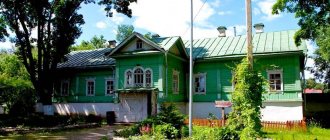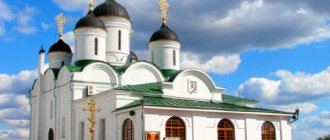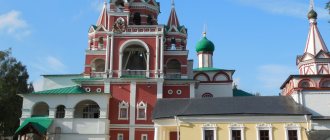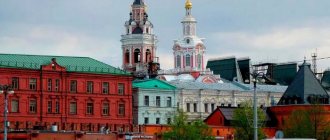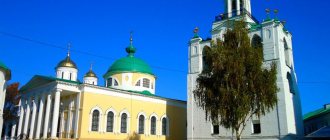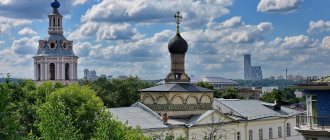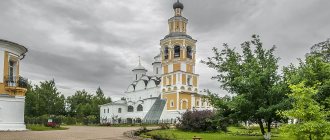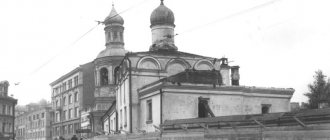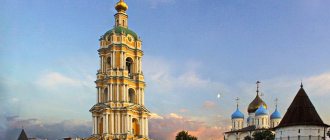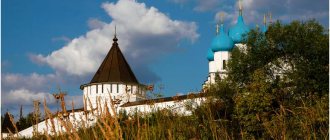Spaso-Preobrazhensky Solovetsky stauropegial monastery
From above, the Solovetsky Monastery looks like a small city surrounded by water. And indeed, there is everything for life inside. They say that even the underground passages have been preserved, which is not surprising considering how the monks were repeatedly attacked.
Holy Gate
The prototype for the construction of the Holy Gate was the Golden Gate in Jerusalem. Photo: globallookpress.com
Through them you will get to the territory of the monastery. The Holy Gate is crowned with a cross. White columns support the dome: previously, a gate church was built at the entrance to the monastery. You will be amazed at the thickness of the gate, made of huge stones. Above the arch through which you will pass hangs an image of the Savior Not Made by Hands. Pilgrims stop in front of him and cross themselves. Women already put on headscarves at the entrance - despite the fact that the place is touristic, the functioning temple obliges you to observe Orthodox canons.
Monastery courtyard
Go through the gate and you will find yourself in the courtyard, immediately in front of you will be the Transfiguration Cathedral. The paths are paved with stone. In summer, there are green, well-groomed lawns and many flowers, and the scent of roses is in the air. From here the tour of the monastery begins. But you are also allowed to come in and see everything on your own. Entrance to the territory and buildings of the monastery is free.
Transfiguration Cathedral
Passing through the Holy Gate you will see the large Transfiguration Cathedral. Photo: Olga MEDVEDEVA
The main temple of the monastery is the Transfiguration Cathedral. It began to be built under that same abbot Philip, in 1558-1566. It was redesigned and built on many times, so if you compare it with its image of past centuries, you will find a lot of differences. What is unusual for us is the entrance to what is supposedly the second floor, that is, when entering the church, you do not find yourself in a room with an iconostasis and an altar, but on the lower tier, from which you need to climb the stairs to the main hall. Divine services are held here, and there is a church shop where you can buy candles and order prayer services. Exhibitions are held in a separate room on the same floor. In 2021, for example, the exhibition was dedicated to the 100th anniversary of the execution of the Romanov royal family, whose members were subsequently canonized.
Assumption refectory complex
The first stone buildings in the Solovetsky Monastery were erected in this complex. It was built in 1552-1557. The Assumption Church was originally wooden - it was built this way several times, but it did not survive the fires that happened. Then they began to build a complex of boulders, stones and bricks - a brick factory was specially built not far from here. Now all the pilgrims and tourists who come to Solovki dine in the refectory of this complex. Lenten dishes are prepared here: fish, mushrooms, vegetable soups and salads, compotes from local berries, and sweet pastries.
St. Nicholas Church
St. Nicholas Church (to the right of the bell tower) was one of the first to appear on the territory of the monastery. Photo: globallookpress.com
He was one of the first to appear in the monastery. It is known that Nicholas the Wonderworker is the patron saint of travelers and sailors. On Solovki he is especially revered, because the life of the islands is inextricably linked with water - lakes, canals and the White Sea. St. Nicholas Church stands between the bell tower and the Trinity Cathedral.
Bell tower
Traditionally, the tallest building in any monastery is the bell tower; on Solovki its height is 50 meters. The one we see now dates back to 1777. At the beginning of the 20th century there were 35 bells here, now there are fewer, but restoration work is underway and new bells are being brought in. And how beautifully the ringing flows throughout the monastery and its surroundings when the bell ringers ring them.
Monastery prison
You will come here on a guided tour. The guide will take you inside, where you will see the tiny rooms where the imprisoned monks were kept, and will also tell you about the fate of Count Peter Tolstoy.
The fact is that at a certain period, Tolstoy and his once friend Pyotr Menshikov disagreed on who should become the successor of Catherine I. Menshikov’s opinion prevailed, and Tolstoy, for “political reasons,” was sentenced to death. He was 82 years old. After some time, the execution was replaced with life imprisonment, and the convict was sent to Solovetsky prison. Tolstoy was deprived of his title of count, and after him his son Ivan was sent to Solovki.
Peter Tolstoy remained in prison for a year and a half and died when he was 84. His son had died eight months earlier.
The development of the Solovetsky Islands began in ancient times - the ancient inhabitants of Pomerania - the proto-Sami - began to appear here; in the summer they hunted sea animals (seals and beluga whales) and fished. In the 2nd–1st millennium BC. The proto-Sami buried their dead tribesmen on Solovki, stacking boulder mounds - mounds - over the remains. In the Middle Ages, the archipelago turned into a place for pagan rituals; there were religious buildings of the Lapps (Sami) - mounds, labyrinths and various symbolic displays of small boulders.
Perhaps the Lapps were still performing their pagan rituals on the islands when the first monks appeared on Solovki at the beginning of the 15th century. The works of the Solovetsky monks turned the pagan region into the center of Orthodoxy in the Russian north.
Founded in 1436 on the distant “edge of the world” islands of the White Sea, the Solovetsky Monastery over time became one of the most famous and revered in Russia. The monastery calendar contains more than 50 names of ascetics of piety who accomplished their spiritual feat on Solovki. The names of the founders of the monastery, Saints Zosima, Savvaty and German, the Anzera miracle workers Eleazar and Job, as well as Saint Philip, Metropolitan of Moscow and All Rus', who, having lived in the Solovetsky Monastery for almost 30 years - 18 of them as abbot, did a lot for it, are deeply revered strengthening and prosperity. Having become a metropolitan, Saint Philip boldly opposed the atrocities of the oprichnina and accepted martyrdom. From the Solovetsky tonsures came two patriarchs - Joasaph I (1634-1641) and Nikon (1652-1658), six metropolitans, several archbishops and bishops, many ascetics famous for their holiness and miracles, as well as prominent historical figures Abraham (Palitsyn), Alexander ( Bulatnikov) and others.
The monastery did a lot to educate pagans on the far outskirts of Russia. One of the very first outstanding ascetics of the Far North was Blessed Theodoret of Kola. During his long 90-year life, the Solovetsky tonsure Archimandrite Theodoret enlightened the gospel word and led thousands of Lapps (Sami) to Christianity. The great merit of the Solovetsky Monastery was the spread of literacy and craft knowledge in Pomerania.
The time of the Solovetsky Sitting (1668–1676) is rightfully considered one of the most tragic periods of monastic history. The revolt of the brethren, who disagreed with the church reforms of Patriarch Nikon, resulted in opposition to the tsarist army. The Solovetsky uprising, suppressed by governor I. A. Meshcherinov, who conducted the siege according to all the rules of war, led to significant casualties on both sides, and also weakened the spiritual traditions and economic position of the island monastery.
The foundation, renewal and existence of seven northern monasteries is associated with the Solovetsky Monastery; up to 30 parish churches were under its jurisdiction. Thousands of pilgrims came to the monastery every year and received spiritual help here. In 1765, the monastery became stauropegial, that is, it came under the direct subordination of the Holy Synod.
The monastery was not only a spiritual, but also a major cultural center. He had one of the best libraries of those times, where new works were stored, copied and created. Such outstanding writers and scribes, tonsures of the Solovetsky Monastery, worked here as Hegumen Dosifei, the initiator of the compilation of the lives of the Monks Zosima and Savvaty at the beginning of the 16th century, the priest Sergius (Shelonin), who lived in the monastery in 1619-1664 (scientists have been studying his works for more than 100 years), monk Epiphanius, etc. The book sign of the Solovetsky library is considered the first bookplate in Russia. The monastery sacristy was the repository of a rich collection of ancient icons, vestments, liturgical vessels, and objects of ancient Russian art. Many of them testify to the close ties of the monastery with the royal house and the Russian patriarchs, the most prominent figures in Russian history. Thousands of valuable icons were in the churches of the monastery.
The documents of the monastery archive are invaluable for science. An interesting collection of ancient weapons was kept in the armory of the monastery. The buildings of the monastery are included in the treasury of world architecture and represent miracles of construction.
The Solovetsky Monastery combined its monastic feat with civic duty: starting from the end of the 16th century, it became the defender of the northern borders of Russia.
Many of its abbots not only fulfilled their direct obedience, but also proved themselves to be skillful politicians and statesmen. Under the abbot Abbot Jacob (1581–1597), a disciple of St. Philip, a stone fortress was built and the Sumsk fort was fortified. Abbot Anthony (1605–1614) during the Time of Troubles showed himself to be a true patriot and a staunch fighter for the interests of Russia, “his prudence saved the Solovetsky monastery, and with it all of Pomerania, from the Swedes.” The correspondence between Abbot Anthony and the Swedish King Charles IX is known, in which he consistently defended the interests of the state. Hegumen Irinarch (1614–1626) did a lot to protect the White Sea region from enemies. The close proximity and frequent military clashes, in which the Solovetsky archers and Pomeranian peasants won victories, inspired the Swedes to respect the monastery.
In 1854, during the Crimean War, when English ships shelled the monastery for nine hours, the brethren and everyone who lived in the monastery, under the leadership of the abbot, Archimandrite Alexander (Pavlovich), showing the greatest courage and heroism, defended the monastery.
The Solovetsky Monastery was also an important economic center; its estates in the 16th-18th centuries, not limited to Pomerania, extended to Lake Onega. In the estates, the monastery boiled salt, being its largest supplier of salt on the domestic market, and also mined mica, pearls, iron ore, and caught sea animals and fish. According to the historian V. O. Klyuchevsky, together with the monastery, “a center and engine of various activities arose in the surrounding Belomorsky region.”
After the secularization of the monastic lands in 1764, the monastery began to more intensively develop the monastic economy on the islands, where up to 40 different industries were located. As a result of reasonable management and environmental management, the islands of the Solovetsky archipelago have achieved a very high degree of improvement. By the beginning of the 20th century, the monastery had 10 hermitages and hermitages, 17 temples (31 altars), and about 30 chapels. Until its closure in 1920, the Solovetsky Monastery was one of the most revered in Russia.
Photos
The Solovetsky Monastery is inextricably linked with the history of our country, with the formation and revival of Orthodoxy in Russia. Photos of the monastery, its Temples, hermitages and deserts can be found in historical and architectural reference books, in Orthodox literature, and on the Internet.
Photos from various years have been preserved: from pre-revolutionary cards to photographs of a modern monastery. There are also images of Solovki during the Great Patriotic War, when the Solovetsky cabin school operated on the territory of the monastery.
Revival of the monastery
In 1967, the Solovetsky Museum-Reserve was created on the island, later transformed into the Solovetsky State Historical, Architectural and Natural Museum-Reserve.
In 1988, a church parish was organized, and the following year Hieromonk German consecrated the chapel of St. Philip; this was the first revived church of the Solovetsky Monastery.
In October 1990, the Holy Synod blessed the opening of the Spaso-Preobrazhensky Stavropegic Monastery.
The Solovetsky Monastery is recognized as a particularly valuable object of cultural heritage of the peoples of Russia. Since 1992, the complex of architectural monuments of the Solovetsky Museum-Reserve has been included in the UNESCO World Heritage List.
Solovetsky Monastery under Abbot Fyodor
Construction of temples
In 1548, when Philip Kolychev (in the world Theodore) became the abbot of the monastery, the Solovetsky Monastery was transformed. On the island, seventy-two lakes were connected by canals, mills appeared, and new outbuildings were built, including the so-called Sushilo. Hegumen Philip proved himself to be an excellent business executive: the monastery's holdings expanded, the economy increased, and at the same time the monastery became the spiritual and cultural center of Northern Pomerania.
Instead of wooden ones, the stone Assumption and Transfiguration Cathedrals were built, and two- and three-story cells were built for the brethren.
In 1566, at a council of bishops, Philip was offered to accept the metropolitan rank and he agreed on the condition that the oprichnina, from which the state was suffering, be destroyed. But Tsar Ivan Vasilyevich believed that oprichnina was necessary for the tsar and for the kingdom.
The first year and a half of Philip's priesthood were calm - there were no cruel massacres in Moscow at that time.
Philip's exile and death
In 1568, returning from an unsuccessful campaign against Lithuania, Ivan IV carried out reprisals against his enemy boyars. Metropolitan Philip stood up for the defense of those innocently convicted and victims of the tsar’s tyranny and conjured him with the Last Judgment of Christ. The king became angry and decided to deal with the saint.
Slanders were found and, on false accusations, the church court condemned Philip to defrocking and imprisonment in a monastery. By order of the tsar, on November 8, 1568, the guardsmen put St. Philip on a log and took him out of the Kremlin, cursing and hitting him with brooms.
In December 1569, the saint was killed in the Tver Monastery at the hands of the guardsman Malyuta Skuratov.
Worship crosses
A memorial cross, carved by the monk Diodorus, a resident of the Holy Ascension Skete, in honor of Saints Anthony and Theodosius, the Pechersk wonderworkers, was installed on the Big Solovetsky Island, six miles from the Solovetsky Monastery on the road to St. Isaac's Skete, on the site of the chapel in honor of Anthony and Theodosius, which was in number lost during the camp. In this small wooden chapel, built at the end of the 18th century, a carved cross from the 17th century was preserved for a long time.
In total, the Solovetsky Monastery installed about 20 crosses at the end of the 20th - beginning of the 21st centuries. According to the abbot of the Spaso-Preobrazhensky Solovetsky Monastery, Archimandrite Joseph (Bratishchev), “the crosses remind of the former greatness of the monastery, as they are installed on the site of lost churches, chapels, and memorial places.”
Also in the summer, the Northern Navigation Partnership installed an 8-meter Orthodox cross in Blagopoluchiya Bay on the rocky ice of Seldyany Cape, which existed before 1917 and served as a kind of lighthouse. Also, on the initiative of the partnership, in 2002 a memorial cross was erected on the site of the Varvara Chapel on the Solovetsky Islands, destroyed in the 1930s.
In the summer of 2007, a river procession “Way of the Cross: Solovki - Butovo” was organized with the transfer of the Great Worship Cross from Solovki to Butovo, timed to coincide with the 70th anniversary of the beginning of mass repressions of 1937-1938.
Construction of defensive structures
The monastery was located on an island, far from homes and there was no great need for protective structures, so the monastery had only a light wooden fence.
During the Livonian War in 1571, when Swedish ships appeared near the islands, at the request of the monastic authorities, Ivan the Terrible decided to build a wooden fortress.
A detachment of archers and gunners who arrived on the island erected several battle towers and a fence made of high pointed logs.
In 1582, the construction of stone structures began to replace the wooden fortress. Construction work took fourteen years and in 1596 the construction of the stone fortress, which became one of the most powerful in the Moscow state, was completed.
The walls and towers were built from boulders using brick and mortar. Looking at the huge cobblestones, it is difficult to imagine how a fortress was built from such huge boulders at a time when there was no construction equipment yet.
The strongest walls were on the southern and northern sides, where it was possible to approach the fortress from land. The width of the walls here reached six meters, and the height - 11 meters; the towers in this part were located quite densely and protruded forward relative to the line of the walls for more convenient shelling of the enemy.
The walls were two-tiered and had rooms for storing weapons. The defensive system also included some utility rooms, and in addition, the fortress was equipped with a large number of weapons.
The construction was supervised by the tonsured Nikolo-Karelian Monastery, the Solovetsky monk Trifon, in the world Terenty Kologrivov, and he was also assisted by a resident of Vologda, the architect Ivan Mikhailov.
The strengthening of the fortress was timely. During troubled times, Swedish ships appeared near the islands, but did not attack the monastery.
Hermitages, deserts, farmsteads
In addition to the monastery itself, there are (existed) several hermitages, hermitages, and farmsteads assigned to the Solovetsky monastery, located both on the Solovetsky Islands themselves and outside them.
- Big Solovetsky Island: Ascension Monastery
- Isaac's Hermitage
- Makarievskaya Hermitage
- Savvatievsky monastery
- Old Pine Wilderness
- Filippovskaya Hermitage
- Golgotha-Crucifixion Skete
- Sergievsky monastery
- St. Andrew's Skete
- Iron Hermitage is an iron-making weapons factory owned by a monastery, operating in the 16th-18th centuries in Korelsky district, founded on the orders of the abbot of the Solovetsky Monastery Philip.
Solovetsky uprising
In 1657, new church liturgical books were sent from Moscow to the monastery. The council of cathedral elders decided to seal these books in the monastery treasury chamber, and conduct services from the old books.
From 1658 to 1668, the monks wrote five petitions to the king, in which they defended the old customs. The monastic brethren did not support the change in rituals, did not accept the correction of church books, and the Solovetsky Monastery remained an important center of the Old Believer movement. In one of the petitions, the monastic brethren wrote: “Do not, sir, send teachers to us in vain, but it is better, if you deign to change the books, send your sword to us in order to move us to eternal life.”
The Moscow authorities sent their abbot Joseph to Solovki, who supported the reforms, but he was expelled from the monastery, and Archimandrite Nikanor was elected rector of the monastery. In response to this challenge, the Great Moscow Cathedral condemned the Old Believers.
The Solovetsky Monastery enjoyed great authority and Tsar Alexei Mikhailovich for a long time did not try to pacify the monastery by force.
The first detachment of archers, led by Voivode Volokhov, was sent to the fortress in 1668 with the goal of taking it by a starvation blockade. But the archers never received any obedience from the monks.
The next detachment under the leadership of Ievlev approached the monastery two years later; it also did not storm the fortress, but the monks did not give up, continuing to defend the monastery.
In the monastery, in case of war with Sweden, large supplies of food and ammunition were collected in advance, sufficient to last for more than eight years.
In 1670, a shootout began, and from 1673, prayers for the sovereign were stopped in the monastery.
Massacre of the rebels
In 1674, the tsar sent a third governor, Ivan Meshcherinov, to Solovki with orders to begin the siege and act more decisively. The defenders of the fortress were excellent in their use of weapons, in addition, they were supported by local fishermen and peasants.
The siege lasted eight years, during which time the monks built several more fortifications, and some archers went over to the side of the monks.
However, a traitor was found who pointed to a bricked-up window through which one could enter the fortress. On the night of January 22, 1676, near the White Tower, tsarist troops entered the fortification, opened the gates and a brutal massacre began. About 30 monks, including Archimandrite Nikanor, were executed on the spot, many were killed later. The surviving monks were sent to other monasteries.
Solovetsky Monastery - foundation
The monk of the Valaam Monastery, Savvaty, dreamed of finding a secluded place for prayer and reflection. He heard many times about uninhabited islands in the White Sea and went to Solovki.
Stopping at the Vyga River, he met the monk Herman, who served in one of the chapels. Together they moved by boat to the shore of Solovetsky Island near Palamanova Bay.
In a beautiful place, where the Savvatievsky monastery is now located, they erected a wooden cross and built cells. Thus, in 1429 the history of the famous Solovetsky Monastery began.
Savvaty and German spent six years in work and incessant prayer. Life in the north was difficult - neither wheat nor rye grew here, the monks ate fish and berries, mushrooms and herbs.
After the death of Savvaty in 1435, Herman brought the young monk Zosima to the island. On the very first night, Zosimus came to a vision - a wonderful temple. In the place where he saw him, the hermits cut down a church in the name of the Transfiguration of the Lord.
Having heard about Herman and Zosima, other residents arrived in the uninhabited, harsh and beautiful region. Soon, Novgorod Archbishop Jonah gave his blessing for the creation of the monastery, and 1436 became the date of the monastery’s foundation.
Its first abbot, sent from Novgorod, could not withstand the harsh conditions of the north and left the island. Then the Monk Zosima became the abbot of the monastery and the spiritual mentor of the brethren. He led the monastery until his death, and he died in 1478 in the Anthony Monastery of Veliky Novgorod.
In the 15th century, the monastery was poor, all its buildings were made of wood, and the life of the monks in the harsh northern region was difficult.
